
During my travel across Mayamar, I made sure to stay at Yangon for I wanted to pay my sincere tribute to the Bahadur Shah Zafar, the last mughal who was exiled to Rangoon in 1859 from Delhi. His tomb is the last reminiscent of the Great Mughal heritage that spans strong across Indian subcontinent. Being a Delhiwallah and an intense lover of history and heritage, it was superlatively natural for me to visit this last Mughal building and bow before the last Mughal who represented last of the last Sufi tradition of Indo-Gangatic plains; who himself was a great poet of charm and accomplishment and facilitated a literally renaissance in Delhi; who stood one last time to safeguard the cosmopolitan culture of the Hindustan but in vain; who profoundly embodied the sophisticated, liberal and plural culture championed by Akbar & Dara Shikoh.
Story of Bahadur Shah Zafar – The Last Mughal

Oil portrait of Bahadur Shah Zafar, Austrian artist August Schoefft. Now preserved in Lahore Museum. PC – Wiki
On a fateful day in 1837, when he was busy living his ascetic life, he was crowned as titular head of Delhi by Britishers and his coronation described him as “His Divine Highness, Caliph of Age, Padshah as Glorious as Jamshed, He who is Surrounded by Hosts of Angels, Shadow of God, Refuge of Islam, Protector of Mohammedan Religion, Offspring of the House of Timur, Greatest Emperor, Mightiest King of Kings, Emperor son of Emperor, Sultan son of Sultan.”
Like Dara Shikoh, he was much in to mysticism & Sufism and a disciple of the Chisti Sufi Order. He followed the spiritual path and showed no inclination in the brutal politics of Shahjahanabad, the walled city of Delhi. He was a fine poet, an accomplished calligrapher and a patron to Urdu poets like Ghalib, Zauk and Mommen. Together they brought a literally renaissance in India making Delhi a true cosmopolitan city where culture, art and etiquette were the way of life. Though merely a titular head with only Delhi as his fiefdom, he was respected as Akbar for his understanding of Hindi-Muslim Unity and hence subsequently proclaimed as Emperor by mutineers of 1857.
He was the last surviving king of great Mongol and Timurid dynasty and born to a Hindu mother. If we go back to lineage of Mughals, we find that early Mangols were followers of Shamanism – a pre-Buddhist religion of Magnolia, Tibet and China, later Mangols of Central and Western Asia converted into Islam and House of Timur was one such off shoot of Mangol Dynasty. Moghuls of the House of Timur were though Muslims but married Hindu Princesses generations after generations. Jahangir, Shah Jahan, Aurangzeb and Bahadur Shah Zafar were all born to Hindu Mothers. So, we can say that Bahadur Shah Zafar had the most cosmopolitan blood in his veins, few ounce each of Shamanism, Islam and Hinduism.
After becoming an accidental emperor, he was never much involved in political and administrative affairs as they were taken care by Britishers. His expenses were always more than the income and hence he was completely dependent on Britishers for sustenance. Ironically, he was an emperor on pension from his subjects as British East India Company was his agent. He had no army under his disposal, no rights to bestow any title to anyone and even no rights to give any gift to anyone. He had to take permission from Mr. Metcalf for everything and anything and Mr. Metcalf was the real ruler of Delhi in those last days of Mughals. Still, however, for most of the Indians Zafar’s appeal was as much political as religious.
After the great uprising of 1857 which started from Meerut and Mutineers entered Delhi from Bridge of Boats on Yamuna and took control of Delhi after proclaiming Zafar as their King and vowed to restore the court of Great Mughals, the one clear source of legitimacy across Indian subcontinent. This followed by an intense fight between Britishers and mutineers, which resulted in mass devastation of Delhi and eventual collapse of first Indian struggle of freedom of 1857. Bahadur Shah Zafar was captured from Humayun Tomb and prosecuted with charge of treason and abatement.
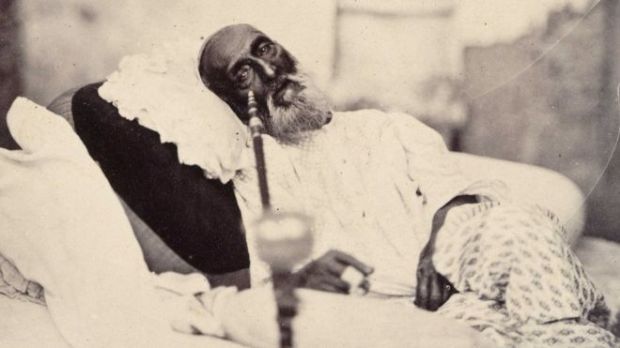
Last photograph of Bahadur Shah Zafar – few days before he was deported to Rangoon.
Story of Tomb of Bahadur Shah Zafar In Yangon
After the great mutiny of 1857 which is also known as first struggle of freedom, Bahadur Shah Zafar was prosecuted and finally decreed to an exile to Rangoon, Burma. At 4 AM on 7th October 1958, he left Delhi on a bullock cart with his wife Zeenat Mahal and two remaining sons and with him went the real character and reputation of Delhi as a global center of trade, culture and learning.
The party of 31 traveled upto Allahabad and then to Mirzapur where they boarded steamers on Ganges, first Thames and then changed to Koyle at Rampur to finally reach Diamond harbor near Kolkata. From Kolkata they were transferred to HMS Magara to reach Rangoon.
After reaching Rangoon, emperor lived on for 4 years before passing away on 7th November 1862 after living an eventful life of 87 years. Zafar’s death officially marked an end of Mughal dynasty that’s lasted for more than 350 years in Indian Subcontinent. In order to ensure that his remains could never be unearthed, he was buried hurriedly half a mile from Shwe Dagon Pagora near main Guard in a brick grave covered with turf level with the ground and fenced with bamboo. It remains so, lost and forgotten and even could not be located when Zeenat Mahal died in 1882. Her body was buried some where near Zafar’s burial place as could be recalled by local people. This game of lost and forgotten continued till 1903 when an Indian delegation reached Rangoon to pay their respect to last emperor.
The guide to this delegation pointed to some tree as burial ground of Zafar and delegation felt sorry with the this treatment to their last emperor. This made the delegation to demand for marking Zafar’s grave and subsequently local Muslims also held demonstration & raised the demand to erect over his remains a tomb. Finally, in 1907, a simple engraved tomb stone was erected which read –
“Bahadur Shah, Ex King of Delhi. Died on 7th November 1862 buried near this spot”
In subsequent years locals installed a structure and converted the place into proper memorial place. Then in 1991, labors while digging a drain unearthed a brick lined grave with an intact skeleton of last Mughal. The Skeleton was shifted to the memorial which is now a pilgrim places and known as Dargah of Bahdur Shah Zafar which is frequently visited by Hindu and Muslims to seek his blessings. Now, the last of the descendant of Mughals and Timurids and Genghis khan is celebrated as pious Sufi Saint by local population. This place has been visited by all states heads of India, Bangladesh and Pakistan since then.
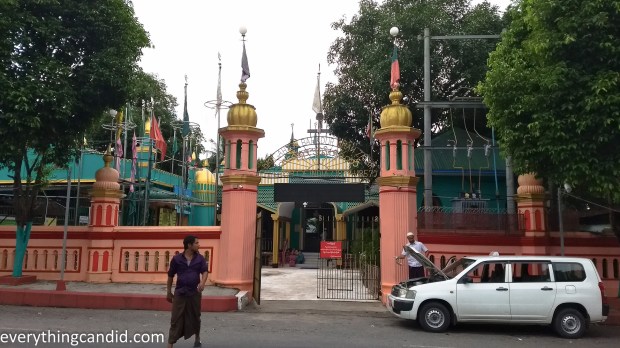
Entrance to Modest Dargah
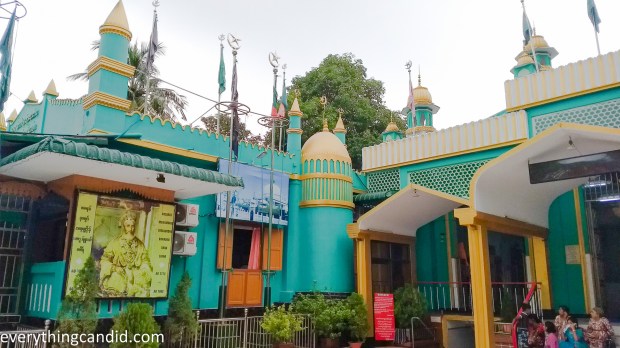
A modest structure at the heart of Yangon known as Dargah of Emperor Saint
Standing in front of this modest building, I was numb and in pain as the full story of Mughals and their forefathers was playing in my mind. In front of me was the building of the last Mughal who was the direct descendant of Great Khan – The Genghis Khan who ruled the largest swath of land in written history and Timur The Lame who founded Timurid Dynasty – the biggest dynasty of Islamic history. Bahadur Shah Zafar was the last ruling emperor of both of these great lineages. He shouldered the burden of this greatness for too long and finally succumbed to the fate at a place called Rangoon which was too far from anywhere, where his forefathers ruled and prospered.
During various conquests, Genghis Khan murdered 50 million people and Timur The Lame 20 million which includes 2 million population of Delhi. They flourished by killing large swath of population and involved in mass genocide which was frivolously fearsome. So, when I was touching the tomb stone of Bahadur Shah Zafar, I could sense the burden of suffering he shouldered of the cruelty his great forefathers bore on the earth. He shouldered all this with nonchalantly and yearned to be a Sufi follower to perhaps ensure Nirvana for his whole clan. He suffered for the fate of his ancestors and paid by his life and loneliness for their cruelty and ruthless massacre across the globe.


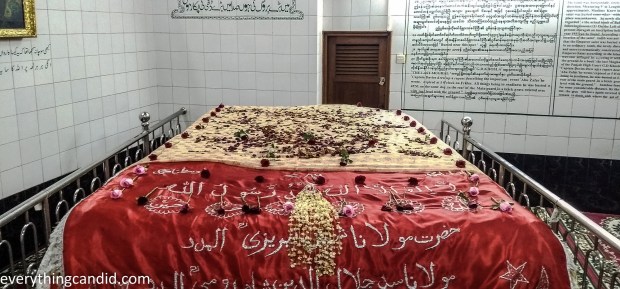
The great ancestors enjoys great mausoleums in various cities of the world while the last of the last descendant died forgotten and his so called tomb was lost and buried under three meter of forgotten dust which was unearthed in 1990s and since then miraculously known as Dargah of Bahadur Shah Zafar which confirms his existence as a Sufi Saints which he always yearned for. His destiny was always in others hand like a kite in tumultuous cloud without a string to control. He wanted a life of an ascetic but lived a life of suppressed; after a forgotten death his Tomb became a Sufi pilgrim and he a Emperor Saint. Bahadur Shah lamented on the irony of his fate in one of his famous couplet thus:

Journey of Mughals started from Fargana in Kazakistan and traversed through Bukhara, Kabul, Lahore, Agra Delhi before ending at Rangoon (Now Yangon). The rule of Mughals was glorious, but their end was tragic.
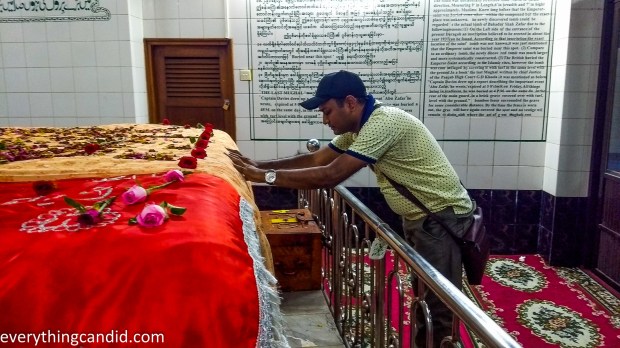
********
After having traced the marks of Great Mughals in Delhi, Agra and Yangon, one day I aim to travel to distant land of Central Asia, Afghanistan, Pakistan and beyond to celebrate the golden age called Mughal Rule.
********
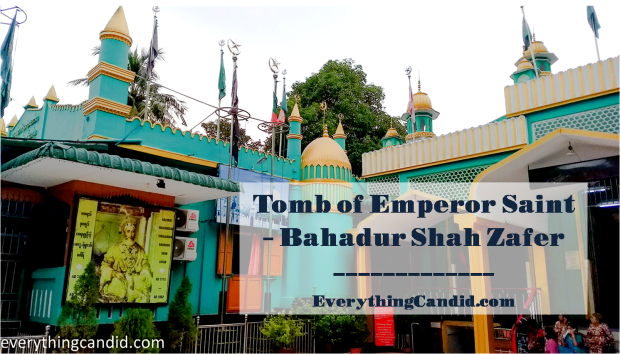
********
Would love to know what you think about my story of Tomb of Last Mughal in Yangon, please comment below.
If you feel motivated, please share this blog post with your loved ones so that they can break the mundane cycle of everyday life and explore the world.
FOLLOW US ON TWITTER | FACEBOOK | INSTAGRAM | PINTERES
********


I heard his story after my trip to Myanmar. Now I’m more disappointed as I’m sure I’ve seen this place from outside but didn’t visit it. But it’s nice to see it through your lense. Thanks !
LikeLiked by 1 person
It was the first place in my mind when I decided to visit Yangon. Pls share link of your Myanmar visit.
LikeLiked by 1 person
Unfortunately, I haven’t moved these articles yet. I’ve only copied it in a word document, as a lot of other articles I still have to move, ah ah.
LikeLiked by 1 person
Will look forward to them 🙂
LikeLiked by 1 person
Yangon is so inspired. I missed his tomb when visiting a year ago but would definitely see it on a return trip. This city feels like a melting pot much more than any SE Asian city. Loved it.
LikeLiked by 1 person
So true. Yangon was once indeed a very cosmopolitan city and still it has a lot to offer.
LikeLike
Loved reading, soon will visit the place , it is on my list since always , thanks for this beautiful write up,
LikeLiked by 1 person
Sounds like a very powerful experience; I had similar emotions visiting a Ghengis Khan exhibit when I was in grade school and will never forget it.
LikeLiked by 1 person
Yes, indeed. It was a different experience. I live the entire setting and just got lost there.
LikeLike
That coffin kinda looks like a bed…
LikeLike
I knew nothing about this chapter of Indian history before reading this post — it’s fascinating. Definitely seems like he had an important role to play in the fight to stop Genghis Khan.
LikeLike
This is interesting. I haven’t heard of this place or of Bahadur Shah Zafar before, but he must have been a really special person to have such devoted worshipers all this time later. Him being buried in a secret location all those years is like the last Czar of Russia, Nicholas. Again, only modern technology allowed him to be found. So nice that Bahadur Shah Zafar could be reunited with his wife.
LikeLike
Truly sad but also hopeful now that the last Mughal’s remains have been recovered. Such a sweet post. It’s heartening to know that the people put together a memorial and that his bones have a somewhat fitting resting place. Wonderful story.
LikeLiked by 1 person
I’m planning a trip to Mayamar and this is a very timely piece for me. The story of Bahadur is such an interesting one.
He became an accidental emperor on a pension under the rule of a brit! The British really do have a lot to answer for back then.
I think after everything he went through, and exile he deserved a decent tomb for those to remember him.
LikeLiked by 1 person
Wow You visited the tomb!!!
I had visited the tomb of Aurangzeb but had very conflicting emotions.
Good that they have given a proper resting place to the last emperor of India.
LikeLiked by 1 person
This looks like a beautiful place to visit. I love that you gave so much history behind it as well. I also love the way travel evolves and starts new traditions. I love that you now have goals for visiting other Great Mughals sites around the world.
LikeLiked by 1 person
What an incredible experience! It’s certainly moving to learn of his story and to see how finally after so many years he was given a proper burial site. To see how people are still so devoted to him shows what a great man he was.
LikeLiked by 1 person
Never heard of Bahadur Shah Zafar before. This is some interesting history. It seems like he was multi talented and a very interesting and skilled person. So sad he couldn’t protect Hindustan culture.
LikeLiked by 1 person
Very little is known of the last Mughal king. I am glad you shared the story of him. Pity that he had to end his life in such a manner. Visiting his last resting place must have been such a lovely experience. I would love to check it out myself.
LikeLiked by 1 person
Such a beautifully written post! I am glad he finally got a proper burial site after all this time.
LikeLike